Being Right: Reclaiming the Founders

The fact that Tea Party activists appeal to the ideals of the American Revolution makes it easy to wrongly conflate the movement with fringe militia groups, as The New York Times recently did in a February 15 article. The title of that article itself, “Tea Party Lights Fuse for Rebellion on the Right” conjures up images of Confederates taking up arms to defend their rights.
The characterization of Tea Party activists as crazy right wing extremists has been comforting rhetoric for those who do not wish to acknowledge the much more widespread discontent concerning how things are being run in D.C., and the Democrats who control Congress and the White House in particular. However, what is attractive about the Tea Party movement is not the few nutcases that hang awkwardly around the movement’s periphery, but the ideals of the American Revolution that the movement draws upon. The Tea Party movement takes its name and its central tenets from those of the Founders. Personal liberty, a limited government and a suspicion of too much government power were the most basic principles upon which the founders built the world’s first large scale democratic republic. These are the same principles that the Tea Party movement wishes to bring to D.C. today.
The New York Times article form earlier this month started out by appearing to take a sympathetic light toward the movement, talking about someone who became a Tea Party activist after previously working for a government housing programs. However, the article then claims a connection between the Tea Party movements and militia groups. The connection though is not at all that evident when one examines the details of the article. In fact the connection the Times draws is between a group called Friends of Liberty and some rather paranoid groups in Idaho.
Friends of Liberty is not the Tea Party movement. However, the Times makes it seem like the Tea Party movement is profoundly intertwined with every militia group or crazy conspiracy theorist out there. The Times even cites a man named Tony Stewart who claims there is a connection between the Tea Party movement and white supremacist groups, though he flat out admits he has no evidence.
Having actually been to a Tea Party march in D.C, I found The Times’ characterization of the movement dead wrong. True there were a couple of dozen crazy people at the rally, but that is out of tens of thousands. Of course, the more crazy you are the more likely your sign gets the attention of the media. The Times did get it half right when they stated that the Tea Party movement “is an amorphous, factionalized uprising with no clear leadership and no centralized structure. Not everyone flocking to the Tea Party movement is worried about dictatorship. Some have a basic aversion to big government, or Mr. Obama, or progressives in general.” Replace some with most and they’ve got it right. True many at the Tea Party were more conservative than me, but few were legitimately worried that the U.S. would soon become a dictatorship.
There have certainly been claims made by people in the Tea Party movement that have no basis in fact, such as claiming Obama wants to set up death panels. However, for eight years I remember hearing people claim Bush was a Nazi, and even people, like former Obama Green Jobs advisor Van Jones, claim that Bush deliberately let 9/11 happen. Conspiracy theories pop up on the fringes of both sides of the political spectrum. Dwelling on the fringe conspiracy theorists misses the point however; people are fed up with what’s going on in D.C. Furthermore, the American people should be at least a little suspicious and concerned when their government moves to take unprecedented levels of control over the automobile, banking and health care industries, all the while racking up unprecedented levels of debt. It might be comforting for the time being for Democrats to believe what they read in The Times and think that those who oppose the agendas of Obama, Pelosi and Reid are just a bunch of nutcases, but when it comes to election season a failure to even acknowledge the strength and composition of their opposition could doom the Democrats.
The Tea Party movement is not just a group of right wing extremists, and certainly the people in Massachusetts who just elected Scott Brown were certainly not far right nuts. The election of Scott Brown and the Tea Party movement represents a growing dissatisfaction with the leftward direction this nation is taking. This dissatisfaction is not a fringe phenomena but a mainstream one. The Tea Party’s combination of a return to the Reagan era’s emphasis on tax cuts, an emphasis on fiscal responsibility, and the Founder’s vision of a limited government which allows individual liberty to flourish is gaining greater and greater support among the electorate.
The Founders certainly failed to extend their vision of a limited government across racial and gender lines, but this does not mean that their vision was wrong; it was simply too narrow. There is no reason why the limited government which the Founders envisioned cannot coexist in a society in which all people are really seen to have been created equal; in fact that is exactly how it should have been from the beginning of this nation. The Tea Party movement is trying to return the nation to the Founders’ vision, through the tired and true American method of mobilizing people and peacefully attempting to influence the government.
The Times has no business comparing this type of movement, which represent exactly what being a member of a democratic republic is all about, to fringe lunatics. The Tea Party movement is trying to bring change to this nation at the ballot box, and if the early polling is correct, they and others upset at how things are going in D.C. will be bringing a great deal of change to the capital in November.







